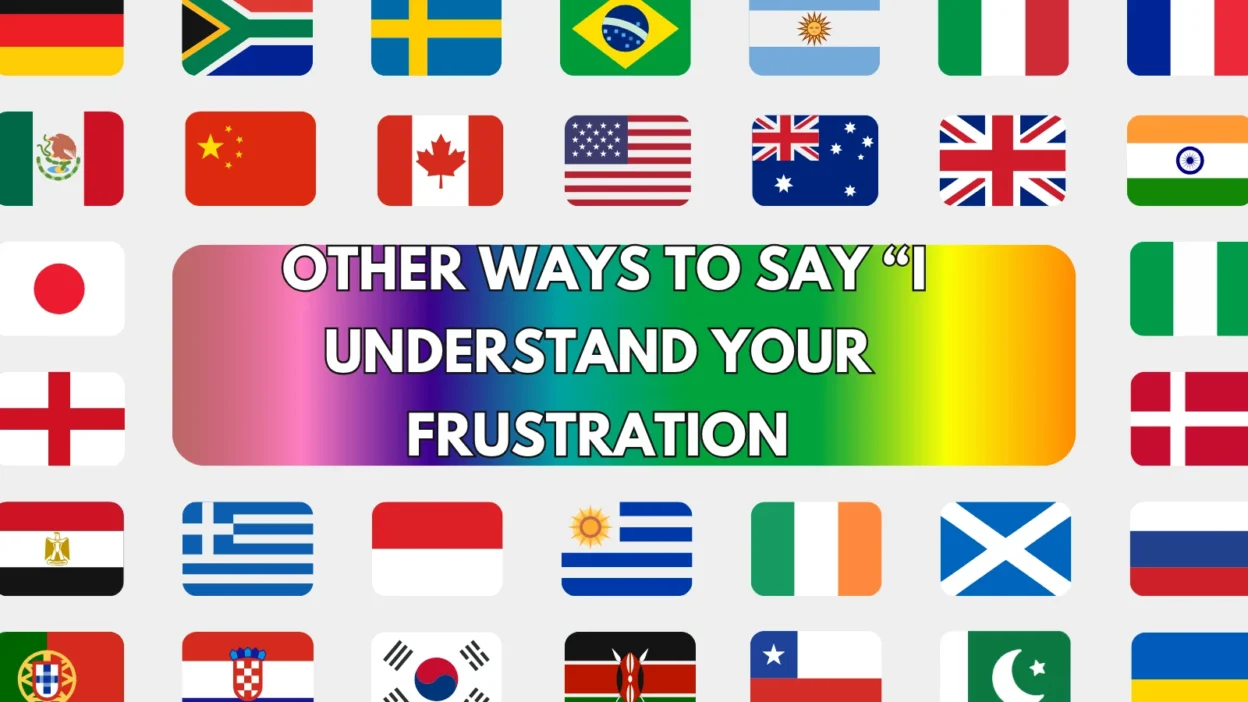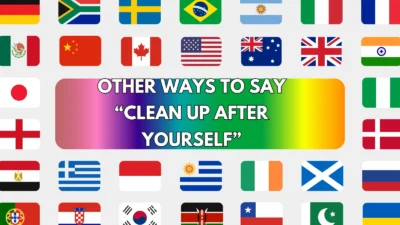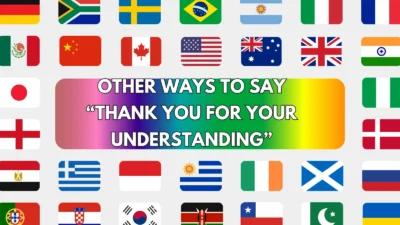When someone feels upset or disappointed, saying “I understand your frustration” is a compassionate way to show empathy and acknowledgment. It helps calm emotions, builds trust, and shows that you genuinely care about what the person is going through. However, there are many other ways to express the same understanding — from professional tones to more heartfelt or supportive ones.
Here are 25 thoughtful alternatives to “I understand your frustration” with meanings, explanations, examples, and tones to help you respond kindly and effectively in any situation.
1. I can see why you’d feel that way
Meaning: Validates someone’s emotions by recognizing their perspective.
Detailed Explanation: A gentle, understanding phrase that acknowledges their feelings without judgment.
Scenario Example: I can see why you’d feel that way — the delay must have been really disappointing.
Best Use: Customer support, personal discussions.
Tone: Empathetic, calm.
2. That must be really frustrating
Meaning: Expresses empathy and recognition of their struggle.
Detailed Explanation: Lets the person know you understand the intensity of their feelings.
Scenario Example: That must be really frustrating — especially after all your hard work.
Best Use: Emotional support, conversations about stress.
Tone: Caring, understanding.
3. I get where you’re coming from
Meaning: A friendly way to say you understand someone’s feelings or reasoning.
Detailed Explanation: Adds relatability and shows that you’re listening.
Scenario Example: I get where you’re coming from — it’s tough when things don’t go as planned.
Best Use: Informal talks, friendly settings.
Tone: Supportive, casual.
4. I completely understand how you feel
Meaning: Full acknowledgment of their emotions.
Detailed Explanation: Shows deep empathy and sincerity.
Scenario Example: I completely understand how you feel — that situation would frustrate anyone.
Best Use: Emotional or sensitive conversations.
Tone: Compassionate, sincere.
5. That sounds really upsetting
Meaning: Recognizes the emotional impact of the situation.
Detailed Explanation: Focuses on the person’s feelings rather than the event itself.
Scenario Example: That sounds really upsetting — I’m sorry you had to deal with that.
Best Use: Empathetic listening, comforting others.
Tone: Gentle, caring.
6. I can imagine how that must feel
Meaning: Expresses empathy through perspective-taking.
Detailed Explanation: Helps show understanding even if you haven’t experienced it yourself.
Scenario Example: I can imagine how that must feel — it’s not easy being in that situation.
Best Use: Supportive conversations, conflict resolution.
Tone: Kind, reflective.
7. I hear what you’re saying
Meaning: Shows active listening and acknowledgment.
Detailed Explanation: Reassures the person that you’re paying attention and value their input.
Scenario Example: I hear what you’re saying — we’ll make sure your concerns are addressed.
Best Use: Customer service, workplace settings.
Tone: Respectful, professional.
8. That’s completely understandable
Meaning: Validates their emotional reaction as natural.
Detailed Explanation: A polite and neutral way to show understanding.
Scenario Example: That’s completely understandable — anyone would feel the same.
Best Use: Formal or calm conversations.
Tone: Supportive, composed.
9. I know this situation isn’t easy
Meaning: Acknowledges difficulty while offering empathy.
Detailed Explanation: Balances emotional understanding with reassurance.
Scenario Example: I know this situation isn’t easy — we’ll get through it together.
Best Use: Emotional or supportive contexts.
Tone: Compassionate, reassuring.
10. I realize how upsetting this must be
Meaning: Shows awareness of their emotional discomfort.
Detailed Explanation: Polite and thoughtful, suitable for serious discussions.
Scenario Example: I realize how upsetting this must be — I truly appreciate your patience.
Best Use: Customer or client communications.
Tone: Professional, empathetic.
11. It’s perfectly normal to feel that way
Meaning: Normalizes their emotions to reduce stress or guilt.
Detailed Explanation: Helps the person feel seen and accepted.
Scenario Example: It’s perfectly normal to feel that way — this has been a tough situation.
Best Use: Counseling, mentoring, or emotional support.
Tone: Reassuring, gentle.
12. I appreciate how you’re feeling
Meaning: Combines understanding with respect.
Detailed Explanation: Shows that you’re emotionally aware and value their honesty.
Scenario Example: I appreciate how you’re feeling — your feedback helps us improve.
Best Use: Workplaces, customer service.
Tone: Professional, respectful.
13. I completely get it
Meaning: A simple, direct expression of empathy.
Detailed Explanation: Often used casually but still conveys genuine understanding.
Scenario Example: I completely get it — it’s frustrating when things don’t go smoothly.
Best Use: Informal chats, friendly or peer discussions.
Tone: Relatable, supportive.
14. You have every right to feel that way
Meaning: Validates their emotional response as justified.
Detailed Explanation: Helps them feel respected and not judged.
Scenario Example: You have every right to feel that way — it’s been a difficult process.
Best Use: Conflict resolution, emotional discussions.
Tone: Respectful, empathetic.
15. I’d feel the same in your position
Meaning: Expresses shared empathy and perspective.
Detailed Explanation: Builds emotional connection by showing relatability.
Scenario Example: I’d feel the same in your position — it’s a lot to handle.
Best Use: Comforting or understanding conversations.
Tone: Honest, relatable.
16. I can tell this means a lot to you
Meaning: Acknowledges emotional importance and sensitivity.
Detailed Explanation: Helps convey attentiveness and care.
Scenario Example: I can tell this means a lot to you — let’s find a way to make it right.
Best Use: Emotional support, feedback sessions.
Tone: Compassionate, attentive.
17. I completely empathize with you
Meaning: Formal and deep expression of emotional understanding.
Detailed Explanation: Shows genuine connection and emotional intelligence.
Scenario Example: I completely empathize with you — I know this has been stressful.
Best Use: Professional, formal empathy.
Tone: Warm, professional.
18. That must have been difficult
Meaning: Recognizes the emotional challenge of the experience.
Detailed Explanation: Encourages the person to feel heard without exaggeration.
Scenario Example: That must have been difficult — thank you for sharing it with me.
Best Use: Emotional, reflective conversations.
Tone: Kind, understanding.
19. I get how annoying that can be
Meaning: A casual way to show shared frustration.
Detailed Explanation: Makes your response feel relatable and human.
Scenario Example: I get how annoying that can be — it’s happened to me before too.
Best Use: Friendly or informal exchanges.
Tone: Light, understanding.
20. I know this isn’t what you expected
Meaning: Acknowledges disappointment gently.
Detailed Explanation: Helps balance honesty with empathy.
Scenario Example: I know this isn’t what you expected — let’s see what we can do next.
Best Use: Customer support, mentoring.
Tone: Calm, reassuring.
21. I’m sorry this has been frustrating
Meaning: Combines apology with understanding.
Detailed Explanation: Useful when expressing empathy and responsibility.
Scenario Example: I’m sorry this has been frustrating — we’ll fix it as soon as possible.
Best Use: Customer service, professional settings.
Tone: Polite, empathetic.
22. I can sense your frustration
Meaning: Acknowledges their emotions through observation.
Detailed Explanation: Helps the other person feel recognized without judgment.
Scenario Example: I can sense your frustration — let’s talk about how we can move forward.
Best Use: Meetings, emotional conversations.
Tone: Respectful, calm.
23. I know this has been challenging
Meaning: Recognizes ongoing struggle without minimizing it.
Detailed Explanation: Encourages continued communication and patience.
Scenario Example: I know this has been challenging — thank you for sticking with it.
Best Use: Work discussions, personal challenges.
Tone: Appreciative, understanding.
24. I see how this situation affected you
Meaning: Focuses on their emotional reaction and experience.
Detailed Explanation: Validates their perspective while maintaining empathy.
Scenario Example: I see how this situation affected you — your feelings make total sense.
Best Use: Counseling, management, relationship conversations.
Tone: Thoughtful, calm.
25. I understand why you’re upset
Meaning: Clear and gentle acknowledgment of their emotion.
Detailed Explanation: Reassures the person that you accept their feelings without judgment.
Scenario Example: I understand why you’re upset — let’s see how we can make it right.
Best Use: Emotional or conflict-resolution moments.
Tone: Sincere, caring.
Conclusion
Saying “I understand your frustration” shows empathy, but using different expressions can make your words feel more genuine and specific to the situation. Whether you say “I can see why you’d feel that way,” “That must be really frustrating,” or “You have every right to feel that way,” each phrase communicates care, patience, and emotional intelligence.
Choosing the right one can help you connect better, calm tension, and show true understanding in both personal and professional conversations.




